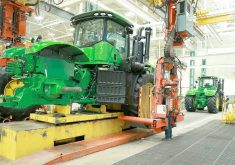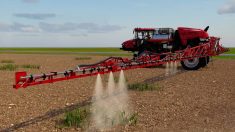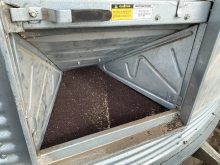Invest Grain farmers will be paying more so investors are attracted to CN and CP shares
Recently the Canadian Transportation Agency (CTA) announced that Prairie grain farmers will pay 9.5 per cent more to ship their grain. Based on the 2011 total freight bill under the revenue cap of $952 million, a 9.5 per cent increase means another $90 million straight out of the pockets of Prairie farmers.
Based on 31 million tonnes shipped in 2011, the average freight rate was $31.71 per tonne. A 9.5 per cent increase means another $2.92 per tonne in freight, or about $3 per seeded acre.
Most of the 9.5 per cent increase has little to do with the actual costs of hauling grain. In fact, the price index for the actual costs of hauling grain went up by only 1.6 per cent. Most of the increase — about 7.9 per cent — is a result of two changes in accounting methodology made by the CTA to the way it calculates the railways’ corporate costs.
Read Also

Farm equipment sales sector sees significant structural changes
Farming equipment sales have been declining for a number of years now, and one industry professional believes structural changes in the industry are needed to curb that trend.
According to the CTA website, the first change is based on recommendations from the railways to change the way the CTA calculates the “cost of equity” component of the cost of capital.
According to the CTA: “Cost of capital is defined as an estimate of the total return on net investment that is required by shareholders and debt holders so that debt costs can be paid and equity investors can be provided with an adequate return on investment consistent with the risks assumed for the period under consideration…
“The new methodology is nearly identical to the previous methodology, but differs in establishing the cost rate of equity…”
So, the change to the CTA’s cost of equity calculation has been done to ensure that CN and CP shareholders are provided an “adequate return on investment consistent with the risks assumed.”
Grain farmers will be paying more so investors are attracted to CN and CP shares.
But, is investing in CN and CP actually risky?
APAS has learned from discussions at industry events that major investment firms in Western Canada have been advising their clients to invest in CN and CP.
When we asked why, the answer was simple: “Barrier to entry.” In other words, the railways have a monopoly; they have a captive market in grain and face no meaningful competition — as farmers have always known.
Thus, there is very little risk investing in CN and CP as the trend in their share values and dividend payments attest.
From January 1, 2003 to May 1, 2012, CN share price has gone up about 400 per cent while CP share price has gone up nearly 250 per cent. From 2001 to 2012, CN dividends on their shares have increased every year, a total of 388 per cent, while CP dividends have increased eight of 11 years, a total of 275 per cent. The revenue cap for grain has never prevented the railways from meeting their cost of equity.
The second accounting change is the way the CTA determines how much the railways get to cover their pensions. Grain farmers will now pay more for funding CN and CP pension plans.
This is not due to more employees. CN employed about the same number in 2011 as in 2002. However, the cost to cover pensions to senior management may have gone up. For example, the CEO of Canadian Pacific is entitled to a pension at age 65 of $1.122 million, according to its 2011 annual meeting information.
Is it really true that CN and CP need more money from farmers to fund their pension plans?
Net income after taxes for CN and CP combined in 2011 was $3.027 billion. The net income after tax for two railways was at least 25 per cent higher than the net income before tax for all Prairie grain farmers combined in 2011, which was a record year for farm net income. The revenue cap for grain does not limit the railway profitability to cover their pension plans.
Who is taking care of the grain farmers’ cost of equity or their pensions?
The 2010 Travacon study showed that in 2007-08 and 2008-09 farmers were paying $6.57 per tonne more to the railways than they should be for freight. Deducting that amount from the 2011 average freight rate of $30.71 gets you down to a “reasonable” grain freight rate of about $24 per tonne.
Not only has the freight bill been too high for years under the revenue cap, grain farmers are now being asked to pay an additional $3 per tonne.
As APAS continues to call for a full costing review, the need grows.
Farmers could understand a 1.6 per cent increase in the revenue cap based on a rising price index for actual costs. But an extra 7.9 per cent to increase railway profits by another $75 million so shareholders are happy and million-dollar CEO pensions are safe is another matter.














